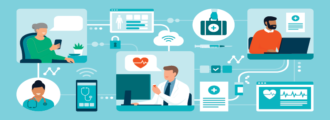Top Tech Challenges Facing Healthcare Professionals Today
NOVEMBER, 2016
HL7 News
With HL7, the mission is simple: digital records that can be easily accessed by anyone involved in a patient’s care.
Or, if you want to get technical, “Health Level-7 or HL7 refers to a set of international standards for transfer of clinical and administrative data between software applications used by various healthcare providers. These standards focus on the application layer, which is ‘layer 7’ in the OSI model.”
In an industry where many remember the days when all record-keeping was done with paper and ink, creating these new technology standards comes with a multitude of challenges.
Records kept by different facilities need to be interchangeable; the file formats and structure need to be consistent enough that they can be read by different software at different facilities.
If you’ve ever tried to open a PDF on a computer that didn’t have Acrobat Reader installed, or a Word document on a Mac without Microsoft Suite, you understand this problem instantly.
But security concerns have led each company to develop proprietary file formats, which do help ensure security but which make interoperability significantly more difficult.
When we asked healthcare IT professionals on our 2016 HL7 Interface Technology Survey what their organization’s biggest current “interoperability” challenge was, 14% indicated lack of industry standards.
Challenge 2: Security
As this article on the Modern Medicine Network so nicely highlights, many healthcare organizations feel torn between the incentives Medicare offers for the meaningful use of Electronic Health Records (EHRs) and HIPAA, which makes healthcare providers accountable for keeping protected health information (PHI) confidential.
It’s easy to understand why this is the case. Understanding of the technologies available for interoperability are low among non-IT professionals (and, in some cases, even among those who specialize in Health IT).
ONC representatives have come out several times to say that the two are not as at odds as it may seem — and that the fear is largely caused by software developers who are seeking a competitive advantage. Still, many organizations would rather play it safe than risk what could be hundreds of thousands of dollars in fines for violating HIPAA or invest the time it might take to reach a true understanding of the guidelines that exist.
Challenge 3: Resource Limitations
In our annual HL7 Interface Technology Survey, integration staff noted that they expected a significant growth in their HL7 workload with few indicating that they expected a similar growth in their budget for those same efforts (get your copy of the full results here).
Limited resources will limit how quickly health care organizations can adopt new standards and implement new technologies. When asked specifically about what their organization’s biggest current “interoperability” challenge was, 18% indicated budget as a problem.
Challenge 4: End User Adoption
Change is always hard. Even after all the other challenges have been overcome, staff must be still be taught how to work these new systems — and often the biggest challenge of digital transformation is getting buy in from end-users who don’t understand the benefits of or don’t have time to learn a new way of doing things.
For those healthcare professionals who spend their days primarily dealing with crises situations, taking time out to understand what is still largely a hypothetical future can be difficult.
Even when interoperability offers significant care advantages, learning these systems requires dedicated time and sometimes requires additional time from healthcare professionals to create additional documentation to feed into this system.




